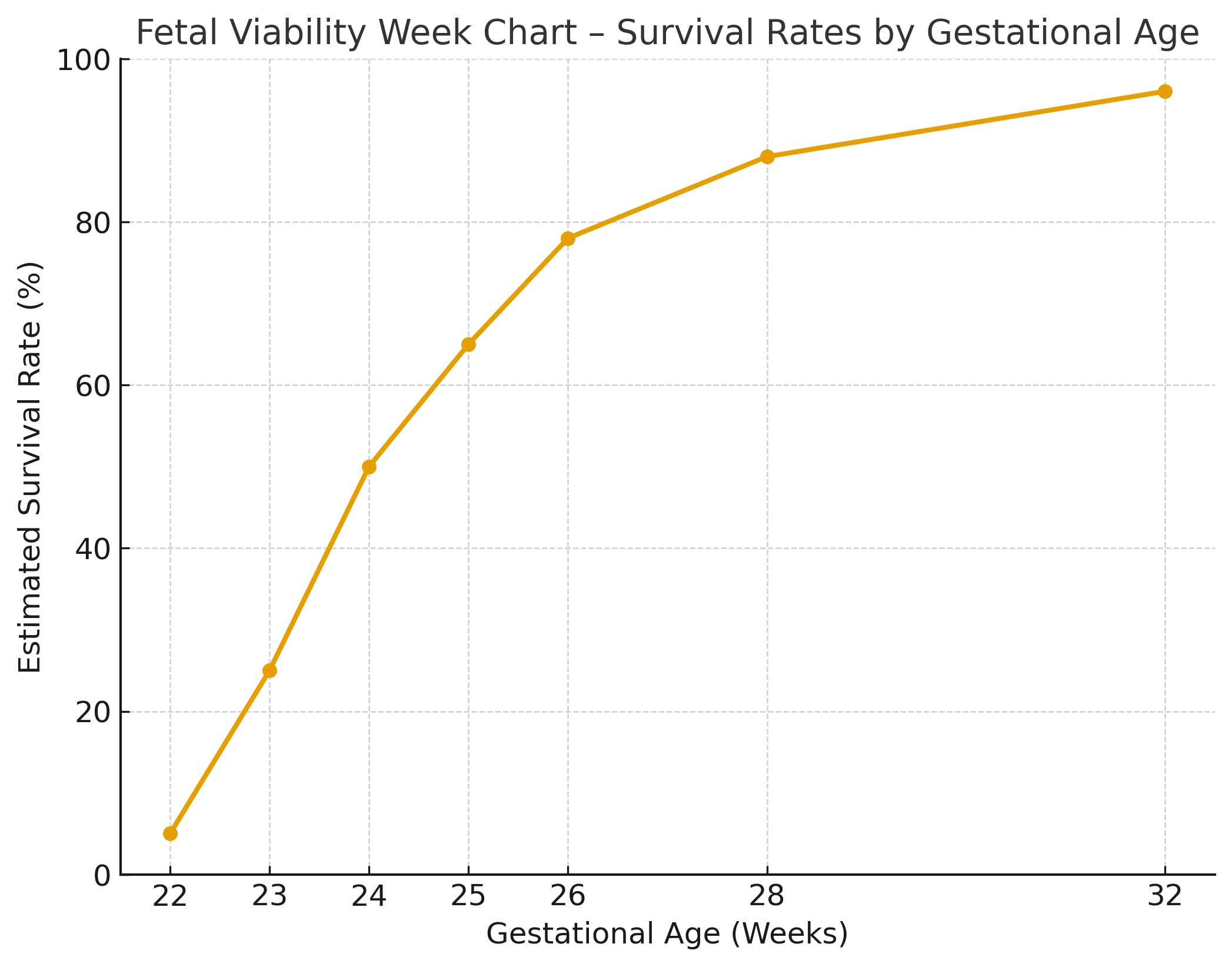
What Is Viability Week in Pregnancy?
Viability week refers to the point in pregnancy when a fetus can potentially survive outside the womb with medical support. While the exact timing varies, modern medical consensus generally places this milestone between 23 and 24 weeks of gestation. This stage marks an important turning point for both parents and doctors when making decisions around prenatal care, delivery, and neonatal treatment.
The Limit of Viability
The term ‘limit of viability’ describes the earliest point at which a premature baby has a chance of survival outside the womb. Globally, this is usually considered between 23 and 24 weeks. Babies born before this time face extremely low chances of survival, even with advanced medical care.
Fetal Viability by Week – Survival Chart
| Gestational Age (Weeks) | Estimated Survival Rate | Notes |
| Before 23 weeks | Less than 10% | Most hospitals do not attempt resuscitation |
| 23 weeks | 23–27% | High risk of long-term complications |
| 24 weeks | 42–59% | Marked improvement, but still fragile |
| 25 weeks | 60–70% | Better survival and reduced long-term risks |
| 26 weeks | 75–80% | Most babies survive with intensive care |
| 28 weeks | 85–90% | Strong outcomes, lower complication risk |
| 32 weeks | 95%+ | Near full-term survival rates |
Factors That Influence Viability
A baby’s chance of survival depends on multiple factors beyond gestational age, including:
• Gestational age – Every extra day in the womb improves outcomes.
• Medical technology – NICU quality, ventilators, and surfactant therapy are vital.
• Fetal weight – Babies over 600 grams (1.3 lbs) have better odds.
• Fetal sex – Studies suggest female fetuses may have slightly higher survival rates.
• Lung maturity – The lungs are one of the last organs to fully develop.
• Maternal care – Steroid injections before birth help accelerate lung maturity.
Outcomes for Extremely Premature Babies
Survival rates for premature babies are improving thanks to modern NICUs, but challenges remain:
• Before 23 weeks: Survival is extremely rare.
• 23 weeks: 23–27% survive, often with long-term challenges.
• 24 weeks: 42–59% survive; many face breathing and feeding issues.
• 28+ weeks: Most babies survive with much lower risk of lasting health problems.
Case Study – A 24-Week Preemie’s Journey
Maya was born at just 24 weeks, weighing 630 grams. Her parents faced overwhelming uncertainty, but thanks to NICU care—including ventilators, feeding tubes, and around-the-clock monitoring—Maya survived. She spent 4 months in the hospital before going home. Now, at age 3, she is healthy and thriving. Her story highlights both the fragility and resilience of extremely premature infants.
Viability in a Medical Context
Within healthcare, ‘viability’ is used in two contexts:
Early pregnancy viability: In the first trimester, a pregnancy is considered viable if it is developing normally and expected to continue.
Late pregnancy viability: Refers to the ability of the fetus to survive outside the womb.
Viability is always a clinical assessment, not a definitive guarantee, and guides important medical decisions.
Testimonials
‘Our son was born at 25 weeks and is now a thriving teenager. The NICU saved his life.’ – Parent, 42
‘As a neonatologist, I’ve seen survival rates improve dramatically over the last decade.’ – Dr. R, NICU Specialist
‘Viability week is such a milestone—it gave us hope when everything felt uncertain.’ – Mother, 35
FAQs
Q: What does viability week mean in pregnancy?
A: It is the point when a fetus has a chance of survival outside the womb, usually around 23 weeks and often referred to as the 24 weeks viability stage.
Q: What week is viability week in pregnancy?
A: Viability week is generally considered 23–24 weeks, though survival continues to improve after this point.
Q: What is the viability week of a fetus according to WHO?
A: The WHO defines the lower limit of viability as around 22–23 weeks, though many hospitals set policies at 24 weeks.
Q: Is 24 weeks considered viability week?
A: Yes. At 24 weeks, survival rates are significantly higher than at 23 weeks, marking it as the key viability milestone.
For More Info
- IVF Basics – How It Works, Success Rates, and What to Expect
- Embryo Transfer
- Fertility Testing Explained
- Surrogacy Costs (USA vs Canada)
Understanding viability week helps families prepare emotionally and medically. At Surrogacy4All, a trusted surrogacy agency, we combine education with physician-led care to help intended parents make informed decisions.
📞 Call (212) 661-7177 or visit www.surrogacy4all.com to speak with our team.

Dr. Kulsoom Baloch
Dr. Kulsoom Baloch is a dedicated donor coordinator at Egg Donors, leveraging her extensive background in medicine and public health. She holds an MBBS from Ziauddin University, Pakistan, and an MPH from Hofstra University, New York. With three years of clinical experience at prominent hospitals in Karachi, Pakistan, Dr. Baloch has honed her skills in patient care and medical research.






